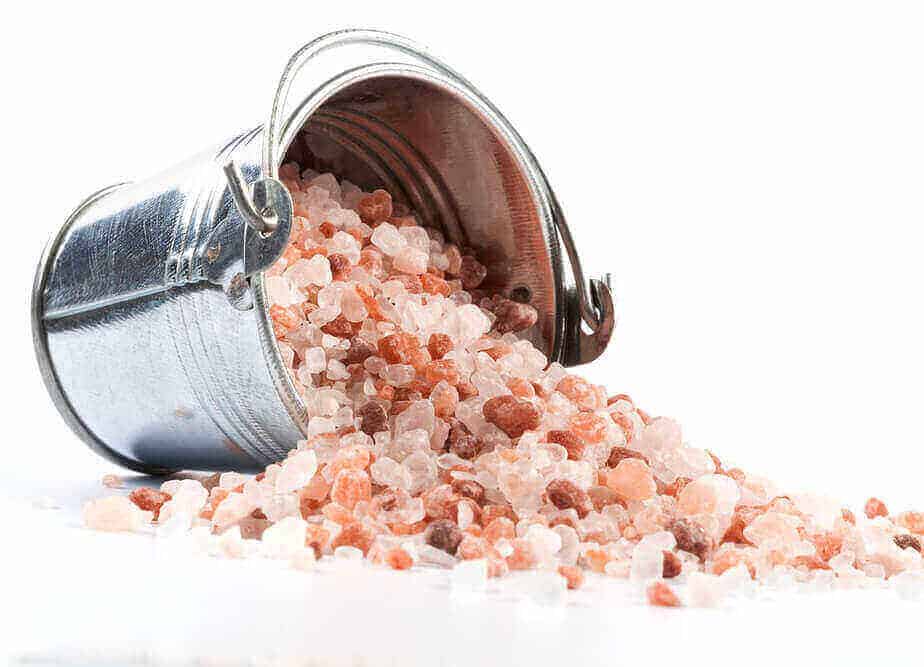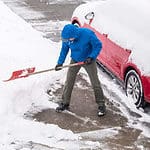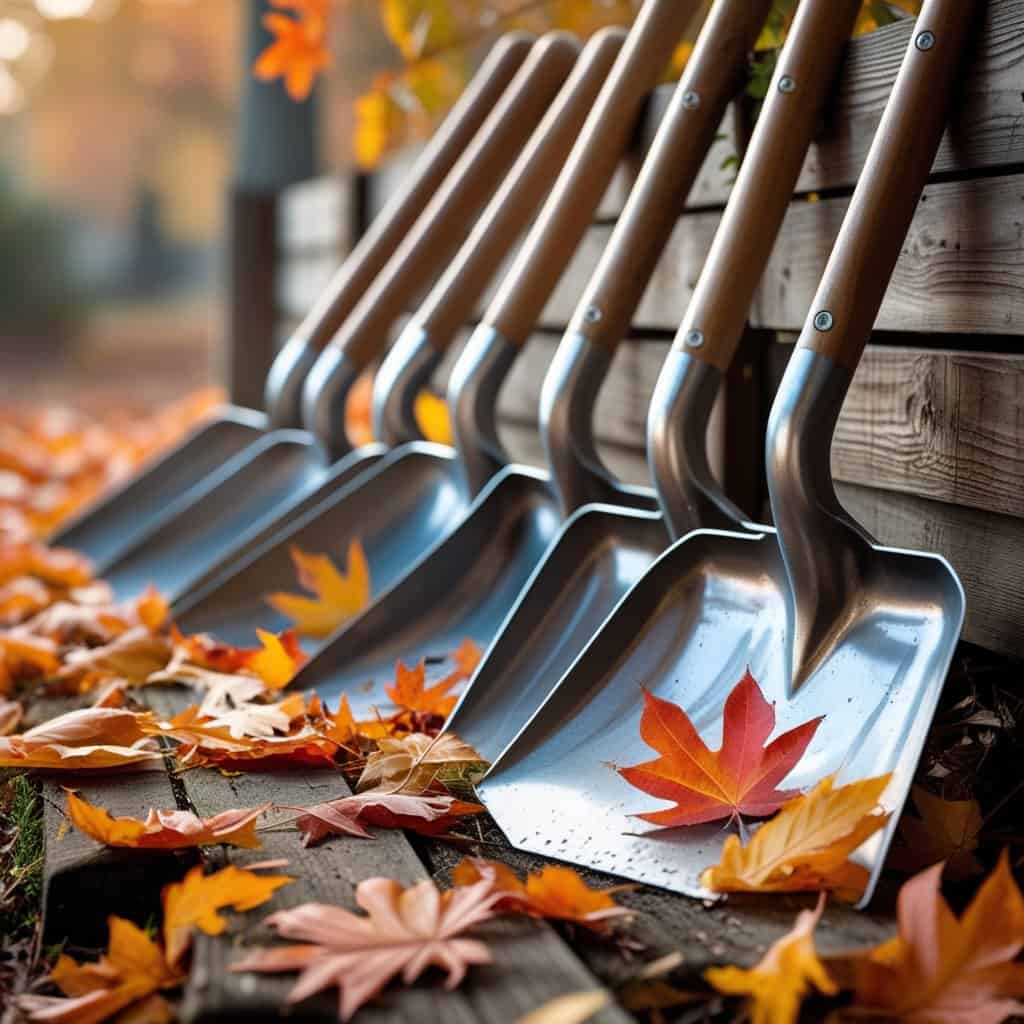There are a few different reasons why clearing away ice is essential. First, as we all know, ice can be dangerous and lead to broken bones and injury if people slip and fall. In addition, ice can damage your property and be a hassle for people and animals who have to walk or drive on icy walks and roads.
When it comes to melting ice, there are a few different options: sand, salt, de-icer or snow melters all lower the freezing point of water, which helps to melt ice.
Table of Contents
When to Use Ice Melt
Ice melt is only applicable when the temperature is below zero or heading there to prevent ice from forming. As ice melt products can damage surfaces such as lawns and concrete, use must be carefully considered.
Most de-icers are safe to use, but it is always best to follow the manufacturer’s instructions. In addition, some de-icers can harm plants and animals if misused.
The amount of de-icer needed will vary depending on the severity of the ice. Generally, it is best to err on using too little rather than too much. Applying too much de-icer can lead to runoff and pollution.
If there’s snow or sleet in the forecast, you may want to wait to use ice melt until after the precipitation has stopped, as this will help reduce damage to lawns and concrete and prevent the tracking of de-icer into your home from everyone’s footwear.
Top 10 Ways To Melt Ice With Little To No Effort
1. Salt
The use of salt is one of the most common ways to melt ice on driveways as salt lowers the freezing point of water, which helps to melt ice. Will table salt melt ice many ask and the answer is that it will but the quantiy required as the grains are so tiny will be cost prohibitive.
Table salt is not utilized unless you are in a pinch. You will find most use rock salt. You can pre-treat your driveway before a storm hits or apply it afterward.
To use salt for melting ice, sprinkle it on the icy areas of your driveway or walkway. You’ll want to use enough salt to cover the entire area, but be careful not to use too much as it can damage concrete and plants. In addition, many pet owners will avoid using salt as they wonder if ice melt is safe for pets and to keep their pets from getting salt in their paws.
Once you’ve sprinkled the salt, wait for it to work its magic and sweep up excess salt remaining before it has a chance to track into your home.
Pros: Safe and effective
Cons: It can be messy
2. Sand
Sand is another effective way to melt ice on driveways and is a good option for gravel driveways. It provides traction so that vehicles and pedestrians don’t slip and absorbs heat from the sun, which helps to melt the ice. Sand is a natural product that is effective at melting ice; however, it can be difficult to spread and make a bit of a mess.
Pros: A natural product
Cons: Difficult to spread, so it can be messy
3. De-icer, Pellet Melters or Snow Melters
Many commercial de-icers on the market can effectively melt ice on driveways. Like salt, commercial snow melts or de-icers work by lowering the freezing point of water, which helps to melt ice. In addition, most de-icers contain calcium chloride, so if you’re looking for an effective way to melt ice on your driveway or walkway, calcium chloride is a good option. Just be sure to use it carefully to avoid damaging your concrete.
Pros: Calcium chloride is effective at melting ice quickly. It is a pet safe ice melt and is also safe to use around children.
Cons: Calcium chloride can be corrosive and damaging to concrete. It can also track into your home.
4. Hot Water
Simply pour a pot of boiling water onto small patches of ice on your driveway and let it work its magic. Be careful not to splash any onto plants or animals, as the hot water can scald them. This method is best for small areas of ice.
Pros: Melts ice quickly when it is a small area.
Cons: Hot water is dangerous to work with. The effectiveness is weather and outdoor temperature dependent and may last only a few moments.
5. Hair Dryer Or Heat Gun
Believe it or not, a hairdryer can help to melt ice on driveways. Just keep it moving, so you don’t overheat any one spot.
Pros: It will melt the ice and evaporate the water.
Cons: Requires a weather-resistant cord and is only practical on small areas such as stairs into the house.
6. Ice Pick
If you have a small area of ice that you need to remove, an ice pick can be helpful. Use caution when picking away at the ice so you don’t damage your driveway. Try using your garden fork at an angle, like a shovel, to get under the ice, and you will find the ice lifts amazingly.
Pros: It will remove the ice and, if combined with other methods, is very effective.
Cons: Picking at thick ice for an extended period is time-consuming and hard on the arms and back.
7. Kitty Litter
Sprinkling litter on icy areas can help provide traction and absorb some of the sun’s heat to help melt the ice. As kitty litter does not dissolve the ice, it is best utilized on stairs or entry to your home. As with other de-icers, kitty litter will track into your home.
Pros: Kitty litter does not melt ice but is a great alternative to ensure no one slips by providing traction.
Cons: It does not melt ice.
8. Heated Mats
There are unique mats available that can be placed on driveways, stairs and walkways to help melt the ice. However, these mats use electricity to generate heat, which can be costly.
Pros: Turn the power on, and falling snow will be melted, so no ice ever forms.
Cons: As these mats are electric, they do cost money. The power must be turned on and off as it snows to keep costs down.
9. Liquid De-icer
Liquid de-icers are de-icers that have been dissolved in water and then sprayed onto surfaces before the snow falls to eliminate the potential of ice forming.
Pros: It works very well at keeping ice from forming and can be more precisely applied to reduce environmental impact.
Cons: The effectiveness of the ice melt is reduced as it has been dissolved. It will work but requires planning as one needs to spray the solution before the snow falls, which is not always practical.
10. Call A Professional
If all else fails, or you do not have time to clear the ice, you can always call a professional snow removal service to take care of the ice for you.
Pros: By calling a professional, you will save your back, time and effort.
Cons: This option may not be financially viable, and the odds are that the professional will utilize some form of de-icer to get the job done.
What Makes Different Snow Melters Different?
Effectiveness: The most crucial factor to consider when buying an ice melter is how effective it will be at melting the ice on your driveway or walkway. You’ll want to look for an ice melter that is specifically designed to work in cold weather and can melt ice quickly.
Ease of Use and Cost: Some de-icers cost more than another, and some are easier to use. Find an ice melter that is easy to spread and doesn’t make a mess. Utilize your grass seed spreader at its largest opening to control the disbursement. Many cities encourage a homemade ice melt using a sand/salt mixture and offer locations where you can go and fill up a bucket or two for your winter needs.
Safety: When choosing an ice melter, you will also want to consider safety. Look for an ice melter that is safe to use around pets and children.
With those factors in mind, here are eleven of the best ice melters.
1. Snow Joe AZ-50-CCP Melt-2-Go 94% Pure Calcium Chloride Pellet Ice Melter, 50-lb
2. National Blue Ice Melt 20lb Bucket – Fast Acting Ice Melter – Pet, Plant and Concrete Friendly
4. Ice Melt Pellets (1 Gallon) Safe on Concrete, Asphalt & Wood, Non-Corrosive
5. National Blue Ice Melt 35lb Bucket
6. Diamond Crystal Halite Rock Salt Ice Melter
9. Heat Guns
10. EcoPet Bio Litter 6.6lb Bag
11. Ice Scraper with Galvanized Steel Blade
What Is The Best Ice Melter For My Driveway?
When choosing an ice melter for your driveway, consider how large of an area you are looking to use the ice melter and how much ice you need to melt. Second, consider the type of material on your driveway. It would be ideal if ice did not form on any surface after the work you went to shovelling the pathways clear. Is it my plastic shovel causing this issue you might ask while other ask if its the metal shovel. The answer is it is not the plastic or metal shovel. It is the air temperature, cars idling, and the quantity of vehicle and pedesterian traffic, determines when and if ice will form.
One of the most important things to consider when using salt or sand on your driveway is your driveway’s material, as different types of salt or sand can cause damage. For example, rock salt can damage concrete driveways, while abrasive sand can damage asphalt driveways. Therefore, choosing the right type of salt or sand for your driveway is important to avoid damage.
Salt is a good option if you have a few spots of ice. Salt is safe and effective for a smaller area, but sand pellet melters or calcium chloride are good options if you have a larger area. Both of these products are effective at melting ice quickly, but they can be damaging to concrete if not used carefully.
How To Store And Dispose Of Ice Melt
Ice melt is best stored in a cool, dry place out of reach of children and pets. To avoid contamination, ensure ice melt is kept away from food and water sources. Store in a well labelled plastic container to keep it dry.
Leftover ice melt can be disposed of in several ways. For example, you can spread it on sidewalks or driveways to help melt snow and ice, add it to compost piles, or use it as a de-icer for gutters and downspouts. If you are utilizing rock salt it can be used up in an old fashioned ice cream maker during the warmer months.
However, be mindful when disposing into a compost pile as the compost may kill enzymes and plant life. So if you have a weedy area where you are not looking to grow anything, this may be the location to dispose of the ice melt.
Just remember that ice melt will melt and leech into the soil, and just like ice melt used in gutters and downspouts, contamination may be an issue, especially if collecting rainwater or the gutter downspout drains onto the lawn. The best disposal technique is to use it on ice and store the remainder.
Final Thoughts
There are a few options for melting ice on your driveway or walkway. Each option has its pros and cons, so consider all factors before making your final decision.
Salt is a safe and practical choice for most people. However, it can be messy and track into your home if you’re not careful. Sand pellet melters are effective at melting ice quickly but can be difficult to spread and make a bit of a mess. Calcium chloride is also effective at melting ice but can be corrosive and damaging to concrete if not used carefully.







